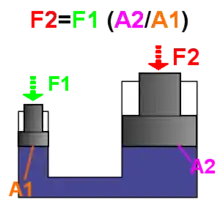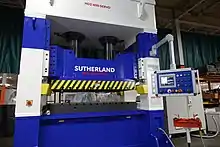Hydraulic press
A hydraulic press is a machine press using a hydraulic cylinder to generate a compressive force. It uses the hydraulic equivalent of a mechanical lever, and was also known as a Bramah press after the inventor, Joseph Bramah, of England.[1] He invented and was issued a patent on this press in 1795. As Bramah (who is also known for his development of the flush toilet) installed toilets, he studied the existing literature on the motion of fluids and put this knowledge into the development of the press.[2]


Main principle
The hydraulic press depends on Pascal's principle-the pressure throughout a closed system is constant. One part of the system is a piston acting as a pump, with a modest mechanical force acting on a small cross-sectional area; the other part is a piston with a larger area which generates a correspondingly large mechanical force. Only small-diameter tubing (which more easily resists pressure) is needed if the pump is separated from the press cylinder.
Pascal's law: Pressure on a confined fluid is transmitted undiminished and acts with equal force on equal areas and at 90 degrees to the container wall.
A small effort force acts on a small piston. This creates a pressure which is transferred through the hydraulic fluid to a large piston
Application
Hydraulic presses are commonly used for forging, clinching, moulding, blanking, punching, deep drawing, and metal forming operations.[3][4]

In popular culture
In the 900s the diplomat Liutprand of Cremona, when visiting the emperor in the Byzantine Empire, explained that he saw the emperor sitting on a hydraulic throne and that it was "made in such a cunning manner that at one moment it was down on the ground, while at another it rose higher and was seen to be up in the air".[5]
The room featured in Fermat's Room has a design similar to that of a hydraulic press.[6] Boris Artzybasheff also created a drawing of a hydraulic press, in which the press was created out of the shape of a robot. In 2015, the Hydraulic Press Channel, a YouTube channel dedicated to crushing objects with a hydraulic press, was created by Lauri Vuohensilta, a factory owner from Tampere, Finland.[7]
References
- Parker, Dana T. Building Victory: Aircraft Manufacturing in the Los Angeles Area in World War II, p. 87, Cypress, CA, 2013. ISBN 978-0-9897906-0-4.
- Carlisle, Rodney (2004). Scientific American Inventions and Discoveries, p. 266. John Wiley & Sons, Inc., New Jersey. ISBN 0-471-24410-4.
- "All About Hydraulic Press Spares". multitechindia.co.in. Rohit. 30 August 2019. Retrieved 30 August 2019.
- "Advantages of Hydraulic Presses". MetalFormingFacts.com. The Lubrizol Corporation. 4 February 2013. Archived from the original on 20 October 2013. Retrieved 23 August 2013.
- Pevny, Olenka Z. (2000). "Perceptions of Byzantium and Its Neighbors: 843-1261". Yale University Press. p. 94-95.
- "What Hydraulic Press Machine Is". BPThai. Retrieved 2016-06-19.
- "Welcome to the 'Hydraulic Press' YouTube channel, a truly crushing experience". The Washington Post. Retrieved 2016-06-01.
External links
| Wikimedia Commons has media related to Hydraulic presses. |